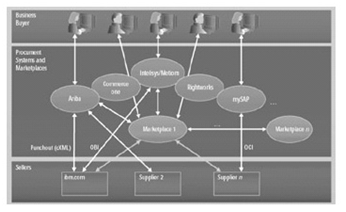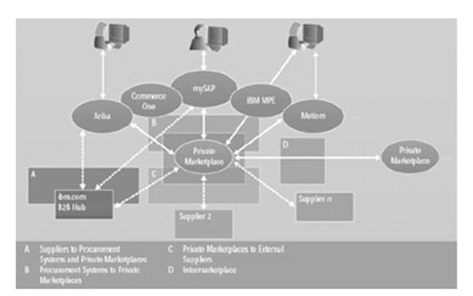THE INTERNET ENVIRONMENT
ELECTRONIC COMMERCE
With the quick growth of the Internet, organizations are more and more using the Web to carry out business with better speed, reach, and effectiveness. This alteration is particularly prevalent in business-to-business (B2B) trade and commerce. Many of the Fortune 500 companies have adopted e-procurement systems such as Commerce One, my SAP and Ariba (see sidebar, "Ariba"). Many others contribute as buyers in e-marketplaces, such as Ariba Hosted Market Place, Commerce One Market Set, and IBM's Web Sphere Commerce Suite, Marketplace Edition (WCS MPE, or MPE for short), among others.
B2B buyers have a variety of procurement systems, such as those offered by Ariba, Commerce One, and SAP, between others. Each of these procurement systems uses unlike B2B protocols for communication with seller systems. Many of these protocols are specific and proprietary to the procurement system. For instance, as illustrated in Fig 1.4. Ariba uses the punch-out procedure between the seller systems using their Commerce XML (CXML, or Commerce Extensible Markup Language) and Ariba Order Request Management System (ORMS) specification for the messages. Commerce One uses XML Common Business Library (XCBL) as the layout of messages, and my SAP uses the Open Catalog Interface (OCI; for a process similar to punch-out) between buyer and seller systems.

Figure: Business-to-business procurement environment
Ariba
With purchasing managers handling the scene of tighter corporate PeopleSoft Inc, budgets, developers Vertical net Inc., and Ariba Inc. are each one readying software that they point to will make possible their customers to improve manage spending. The objective is to make possible companies to more closely bind the process of negotiating the price for those products, finding sources of raw goods, and closing the loop with electronic settlement.
Vertical net has newly released an improved Spend Management element as well as the next version of its Metaprise joint order management and planning suite. Spend Management introduces a supplier enhanced reporting and score card and analytics, which will let suppliers observe through a Web browser how they are serving buyer and performance metrics, such as actual costs versus standard spending. New functionality in Metaprise, which comes from the company's achievement of Atlas Commerce Inc., facilitates the process of improving managing and requisitions purchase orders. improved logistics functionality integrates shipping updates with third-party logistics providers.
in the meantime, PeopleSoft, of Pleasanton, California, newly announced the general ease of use of its strategic sourcing suite. The company unveiled PeopleSoft planned Sourcing as a collaborative solution that helps companies control the complex bidding and negotiation procedure in the procurement of direct goods, large capital expenditures and services according to officials.
Separately Ariba, of Sunnyvale, California, newly unveiled its Spend Management Suite, which has been in beta testing. The suite consists of enhanced and new software modules for procurement, sourcing, and analysis, to help companies supervise their expenses before, during, and after the procurement process-stages that Ariba refers to as "find it," "get it," and "keep it."
In the find-it type, the new Ariba Analysis unit gathers procurement information, which usually resides in the accounts payable, Ariba Buyer platform, and ERP planning systems. It then generates information to help companies locate potential savings.
The second new unit, called Ariba Contracts, falls into the get-it and keep-it categories, by focusing on the management of contracts-those being used effectively and those requiring renegotiation. Integrated with Ariba Buyer and Enterprise Sourcing, the unit helps companies manage and track contract life cycles. Ariba Invoice, the third new module, automates every stage in the invoicing process to help companies decrease reconciliation cycle times and lets suppliers upload invoices into Ariba Supplier Network and broadcast them back to buyers.
Many other protocols for B2B processes, many proprietary to procurement and other systems, and others personalized for definite partners are being implemented and defined. In addition to the procurement systems, which usually exist in within the Firewall of the selling, marketplaces, organizations are being set up on the Internet via which buyers can access a large number of suppliers, normally for exact industry segments. Many of these marketplaces make use of the same or similar technology to attach to procurement and supplier systems and present buyers at small and medium-sized businesses access to suppliers.
In the meantime, standards bodies are important protocols and message formats for B2B processes. One of the early on processes was that definite by the Open Buying on the Internet (OBI) consortium, an ancestor of the punch-out process. The Rosetta Net consortium used OBI as a preliminary point and defined Partner Interchange Processes (PIPs), including both XML-based message formats and flows for communications between partners. The electronic business XML (EBXML) framework (sponsored by the United Nations Center for the Facilitation of Practices and Procedures for Administration Commerce and Transport [UN/ CEFACT] and the Organization for the improvement of Structured Information Standards [OASIS]) includes a messaging service, a Collaborative-Protocol Agreement (CPA) specification, and a Business Processes Specification Schema. These are all used for enabling the interaction between business processes.
The Web services approach defines both a remote procedure call and a messaging mechanism using Simple Object Access Protocol (SOAP). On top of SOAP, the Web Services Description Language (WSDL) defines a Common Object Request Broker Architecture (CORBA) interface definition language (IDL)-like interface for Web-based B2B remote procedure calls. And, the Universal Description, Discovery, and Integration (UDDI) consortium has defined a directory mechanism for registering and locating businesses on the Web, with a possible WSDL interface specification. The Open Application Group (OAG) has defined Business Object Documents (BODs) for the content of B2B messages.
A number of these initially disparate efforts are now coming together. For instance, the Rosetta Net consortium has declared that they will move about to the EBXML messaging protocol, and OAG has declared that they will support EBXML. Regardless of these efforts, though, the number of B2B protocols continues to rise.
This proliferation of B2B protocols gives go up to more than a few connectivity problems and requirements, as illustrated in Figure 1.5. First, from a supplier's opinion, suppliers require to connect to the many private marketplaces and customer procurement systems, using various B2B protocols. Second, private marketplaces (and, over time, procurement systems as well) need to connect to procurement systems, via different B2B protocols. Third, private marketplaces require connecting to suppliers that may maintain different B2B protocols. Fourth, private marketplaces need to connect to each other, in order to access suppliers connected to other marketplaces, or to access services obtainable at other marketplaces.

Figure: Business-to-business connectivity requirements
Now, let's look at the connectivity requirements for suppliers and private marketplaces, and how suppliers and marketplaces relying on IBM's WebSphere Commerce Business Edition (WCBE), WebSphere Commerce Suite, and Marketplace Edition (WCS MPE) can interoperate within the environment for B2B procurement. Simple B2B connectivity using punchout processes as supported by WCBE are also discussed. Next, marketplace connectivity for emerging asynchronous processes and distributed trading mechanisms, as supported by WCS MPE, are discussed. Finally, the last part of this chapter discusses connectivity, how to use a B2B protocol exchange, and how many of these protocols can be mapped to each other-thus allowing procurement systems and suppliers to use different protocols.